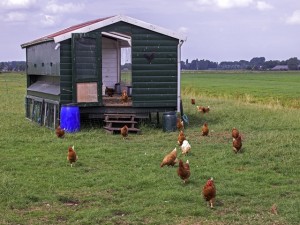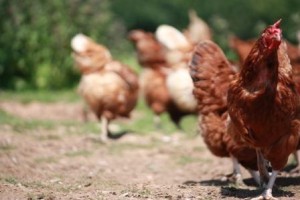Poultry Diseases
Helminthiasis in Poultry
Free range poultry have free access to the open air and the ground, from which they are prone to pick up parasitic infections, some of which have not recently been major problems in the poultry industry under the strictly controlled, continuously housed conditions of intensive rearing (Permin et al., 1999). A survey of helminth parasites in backyard flocks in Michigan by litter examination also showed relatively high contamination rates, irrespective of bird species (Nonaka et al., 1991). Management practices largely dictate the type and severity of internal parasite infestation. Free range poultry may be at more risk than conventionally managed, confined chickens, as there may be greater contact with feces and host organisms such as the earthworm. Additionally, unless an efficient rotational system is in place, free range birds face exposure to contaminated pasture. Environmental factors such as climate, temperature and humidity that influence parasite life-cycle are also more important in free-range systems.
Nematodes
The most important nematode species of poultry are:
- Ascarids
- Heterakis
- Capillarias.
Nematodes, also known as roundworms, are usually elongated, cylindrical and unsegmented worms. They can either have a species-specific direct bird to bird life-cycle, with transmission by ingestion of infective eggs or larvae, or they may have an indirect cycle requiring an intermediate host ((See image)). The Ascaridia, Heterakis and Capillaria species of nematodes are widely distributed, causing non-specific clinical signs of infection, such as loss in appetite and growth, a general loss in condition and, on occasions, deaths.
Aside from the fact that some have intermediate hosts and others direct life cycles, all the nematodes go through the same developmental stages in their life cycle:
- Eggs are laid by mature worms in the gut of infected birds are passed out in feces
- Once outside the body, the eggs undergo development either within an invertebrate host or not.
- In the case of a direct life-cycle, birds become infected by eating embryonated eggs or the freed larvae.
- For those with an indirect life-cycle, the intermediate host ingests the embryonated eggs or free larvae and birds become infected when they consume the host containing the infective larvae.
The length of the life cycle of the various species can last from days to months.
Common nematodes in the digestive tract of poultry:
| Parasite | Bird Host | Lifecycle | Organs infected | Pathogenecity |
|---|---|---|---|---|
| Amidostomum anseris | Duck, goose, pigeon | Direct | Gizzard | Severe |
| Ascaridia galli | Chicken, turkey, duck, quail | Direct | Small intestine | Moderate |
| Ascaridia dissimilis | Turkey | Direct | Small intestine | Moderate |
| Capillaria caudinflata (columbae) | Chicken, turkey, duck, game birds, pigeon | Earthworms | Small intestine | Moderate to severe |
| Capillaria contorta (annulata) | Chicken, turkey, duck, game birds | Direct or earthworms | Mouth, esophagus, crop | Severe |
| Capillaria obsignata | Chicken, turkey, goose, pigeon, quail | Direct | Small intestine, cecum | Severe |
| Cheilospirura hamulosa | Chicken, turkey, game birds | Grasshoppers, beetles | Gizzard | Moderate |
| Cyrnea colini | Turkey, game birds | Cockroaches | Proventriculus | Mild |
| Dispharynx nasuta | Chicken, turkey, game birds, pigeon | Sowbugs? | Proventriculus | Moderate to severe |
| Gongylonema ingluvicola | Chicken, game birds | Beetles and cockroaches | Crop, esophagus, proventriculus | Mild |
| Heterakis gallinarum | Chicken, turkey, duck, game birds | Direct | Cecum | Mild but transmits histomoniasis |
| Ornithostrongylus quadriradiatus | Pigeon, dove | Direct | Small intestine | Severe |
| Subulura brumpti | Chicken, turkey, duck, game birds | Earwigs, grasshoppers, beetles, cockroaches | Cecum | Mild |
| Tetrameres americana | Chicken,, turkey, duck, game birds, pigeon | Grasshoppers, cockroaches | Proventriculus | Moderate to severe |
| Trichostrongylus tenius | Chicken, turkey, duck, game birds, pigeon | Direct | Cecum | Severe |
Cestodes and Trematodes – Poultry Tapeworms
Other internal parasites, less pathogenic than the roundworms, include the trematodes and cestodes (tapeworms). A vast number of trematodes, or poultry tapeworms, have been identified, with a wide range of hosts. The tapeworms require an intermediate host, such as earthworms or insects. Birds can become infected through ingestion of the intermediate host. The most important tapeworm is probably the Raillietina cesticullus. The trematodes are more important parasites of wild water-fowl and domesticated ducks and geese.
Control and Prevention of Helminthiasis in Poultry
This section covers the general aspects of controlling poultry helminthiasis.
In general, the life cycle of worms can be broken by resting the ground and replacing litter between flocks. Interruption of the parasite life cycle is the best approach to control. The method of doing this will depend on the parasite and the poultry system. On the whole, internal parasites are not a problem for ranging poultry where the range is adequately rested and rotated. Systems that rely on mobile housing obviously offer a much greater flexibility in ensuring frequent rotation of ranging paddocks.
If post-mortem examination of any bird takes place, the opportunity should be taken for assessment of the level of infestation, and where necessary, to develop effective control procedures. Occasional fecal egg counts may also be advisable for layers.
It is known that some parasites are able to survive in some conditions for several years. Wehr, in Hofsted (1972), recommends that birds should not remain in a paddock for more than 2-3 months, and that a series of four paddocks should be used rotationally around a central house. Wehr also suggests that rested ground may be planted with a green crop, as there is some evidence that birds are less likely to pick up contaminated soil when there is plenty of green vegetation available.
Some parasites proliferate in wet litter and a build-up may occur when litter is re-used. This should be avoided, particularly for layers. Meat-producing birds, having a shorter life, are less at risk.

Encouraging birds to range a distance from the house, rather than congregating near the house, will assist in diluting the build-up of parasites on the pasture and in the soil.
Keeping grass short will help parasite control. Ultraviolet sunlight appears to kill worm larvae. Harrowing of ground is also a useful control measure. If there is a build-up in fixed house systems in the areas immediately outside the house, it may be necessary to physically remove the top 5cm of soil occasionally.
The grouping of birds of different ages may result in the inter-group spread of parasites, and so this should always be avoided. Furthermore, and possibly more importantly, different species of birds should not be kept together.
Bubier and Bradshaw (1998) recommend that ad lib feeding should be given to poultry, as this has the effect of preventing hens from remaining in or near the house in anticipation of feeding time (Bubier and Bradshaw, 1998).
Keeping poultry on free-draining land, free from excessive shading and away from damp or water-logged areas will also assist in reducing the number of potential intermediate hosts which are common to the life-cycle of many parasites.
Treating Helminthiasis in Poultry
Anthelmintics (also known as de-wormers) are a class of drugs used to treat helminth infections, should a problem exist. The risks of anthelmintic resistance can be reduced by putting in place preventive management measures. A rule of thumb is to use one particular anthelmintic for two years and then change to another type. Anthelmintics must always be used at the correct dose and for the correct length of time.
There is very little literature available on the use of remedies other than anthelmintic for the treatment of helminths in worms. Alternatives to anthelmintics in poultry systems suggested by Thamsborg et al (199) include management of pastures and yards, and provision of clean pasture and cleaning of any permanent facilities between batches (Thamsborg et al., 1999). There is anecdotal evidence, reported by Roderick and Hovi (1999), of success using garlic as a remedy against worms in poultry (Roderick and Hovi, 1999). Other anecdotal successes include the use of cider apple vinegar in water. This is likely to have an effect through promoting general gut health rather than actually controlling worms. Diatomaceous earth is also sometimes cited as a potential wormer but there is no evidence that this is effective in the face of actual worm infestation.
Good Practice based on Current Knowledge
- Implement a run/range rotation system
- Use a rotational paddock system and ensure ground is well rested between batches of birds (a four paddock system is recommended). Organic farmers should note that there are specific regulations that stipulate the requirement for pasture rest periods periodically and between batches of birds
- Ensure a properly selected site for housing and runs: free-draining, preferably sloping
- Do not re-use litter
- Do not spread fresh poultry manure on ground used by poultry
- If a strict rotational system is not possible, periodically remove the top layer of dirt-floored houses and replace with sand or coarse ashes
- Re-seed rested paddocks if possible or integrate into a crop rotation
- Keeping grass short will help in parasite control
- Harrowing of ground is also a useful control measure
- Do not keep birds of different age groups together
- Do not keep different species of birds together
- Encourage ranging activity
- Avoid surface water and fence off wet or water-logged areas
- Avoid damp places in houses
- Use occasional post-mortem examination to assess levels of worm infestation
- Use fecal egg counts to assess worm infestations


 British English
British English


Comments are closed.